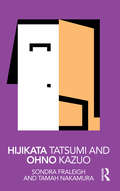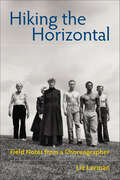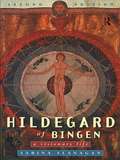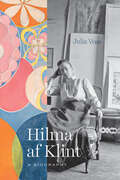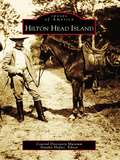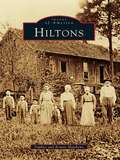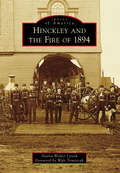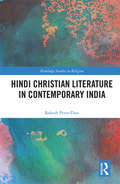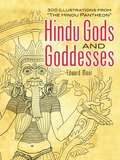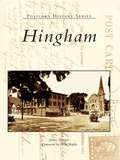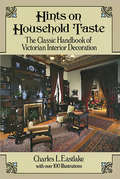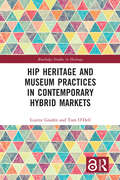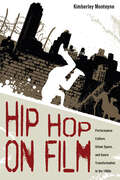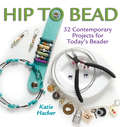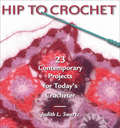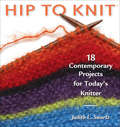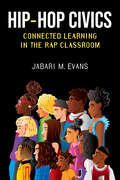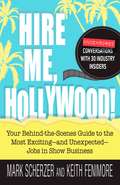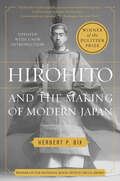- Table View
- List View
Hijikata Tatsumi and Ohno Kazuo (Routledge Performance Practitioners)
by Sondra Fraleigh Tamah NakamuraNow re-issued, this compact book unravels the contribution of one of modern theatre’s most charismatic innovators. Hijikata Tatsumi and Ohno Kazuo combines: • an account of the founding of Japanese butoh through the partnership of Hijikata and Ohno, extending to the larger story of butoh’s international assimilation • an exploration of the impact of the social and political issues of post-World War II Japan on the aesthetic development of butoh • metamorphic dance experiences that students of butoh can explore • a glossary of English and Japanese terms. As a first step towards critical understanding, and as an initial exploration before going on to further, primary research, Routledge Performance Practitioners are unbeatable value for today’s student.
Hikaru's Toy Troubles
by Museum Of ScienceHikaru wonders if he and his friends might be able to use a similar technology as the maglev transportation system to draw customers to his parent's toy store.
Hiking the Horizontal: Field Notes from a Choreographer
by Liz LermanThe unique career of choreographer Liz Lerman has taken her from theater stages to shipyards, and from synagogues to science labs. In this wide-ranging collection of essays and articles, she reflects on her life-long exploration of dance as a vehicle for human insight and understanding of the world around us. Lerman has been described by the Washington Post as "the source of an epochal revolution in the scope and purposes of dance art." Here, she combines broad outlooks on culture and society with practical applications and accessible stories. Her expansive scope encompasses the craft, structure, and inspiration that bring theatrical works to life as well as the applications of art in fields as diverse as faith, aging, particle physics, and human rights law. Offering readers a gentle manifesto describing methods that bring a horizontal focus to bear on a hierarchical world, this is the perfect book for anyone curious about the possible role for art in politics, science, community, motherhood, and the media.
Hildegard of Bingen: A Visionary Life
by Sabina FlanaganDrawing on contemporary sources, the text unfolds Hildegard's life from the time of her entrance into an anchoress's cell--where a woman would remain in pious isolation--to her death as a famed visionary and writer, abbess and confidante of popes and kings, more than seventy years later. Against this background the author explores Hildegard's vast creative work, encompassing theology, medicine, natural history, poetry, and music.
Hilma af Klint: A Biography
by Julia VossA highly anticipated biography of the enigmatic and popular Swedish painter. The Swedish painter Hilma af Klint (1862–1944) was forty-four years old when she broke with the academic tradition in which she had been trained to produce a body of radical, abstract works the likes of which had never been seen before. Today, it is widely accepted that af Klint was one of the earliest abstract academic painters in Europe. But this is only part of her story. Not only was she a working female artist, she was also an avowed clairvoyant and mystic. Like many of the artists at the turn of the twentieth century who developed some version of abstract painting, af Klint studied Theosophy, which holds that science, art, and religion are all reflections of an underlying life-form that can be harnessed through meditation, study, and experimentation. Well before Kandinsky, Mondrian, and Malevich declared themselves the inventors of abstraction, af Klint was working in a nonrepresentational mode, producing a powerful visual language that continues to speak to audiences today. The exhibition of her work in 2018 at the Guggenheim Museum in New York City attracted more than 600,000 visitors, making it the most-attended show in the history of the institution. Despite her enormous popularity, there has not yet been a biography of af Klint—until now. Inspired by her first encounter with the artist’s work in 2008, Julia Voss set out to learn Swedish and research af Klint’s life—not only who the artist was but what drove and inspired her. The result is a fascinating biography of an artist who is as great as she is enigmatic.
Hilma af Klint: A Biography
by Julia VossA highly anticipated biography of the enigmatic and popular Swedish painter. The Swedish painter Hilma af Klint (1862–1944) was forty-four years old when she broke with the academic tradition in which she had been trained to produce a body of radical, abstract works the likes of which had never been seen before. Today, it is widely accepted that af Klint was one of the earliest abstract academic painters in Europe. But this is only part of her story. Not only was she a working female artist, she was also an avowed clairvoyant and mystic. Like many of the artists at the turn of the twentieth century who developed some version of abstract painting, af Klint studied Theosophy, which holds that science, art, and religion are all reflections of an underlying life-form that can be harnessed through meditation, study, and experimentation. Well before Kandinsky, Mondrian, and Malevich declared themselves the inventors of abstraction, af Klint was working in a nonrepresentational mode, producing a powerful visual language that continues to speak to audiences today. The exhibition of her work in 2018 at the Guggenheim Museum in New York City attracted more than 600,000 visitors, making it the most-attended show in the history of the institution. Despite her enormous popularity, there has not yet been a biography of af Klint—until now. Inspired by her first encounter with the artist’s work in 2008, Julia Voss set out to learn Swedish and research af Klint’s life—not only who the artist was but what drove and inspired her. The result is a fascinating biography of an artist who is as great as she is enigmatic.
Hilton Head Island (Images of America)
by Coastal Discovery Museum Natalie HefterHilton Head Island, a celebrated resort community with a colorful and intriguing past, is one of South Carolina's premier tourist destinations. Its scenery and leisure industry attract more than 1.5 million visitors each year to play golf, relax on the beaches, or just to soak up the atmosphere. Before the fairways and hotels ever arrived on the scene, the island already had a long and interesting history dating back as far as 10,000 years ago, when Native Americans first began to visit the area. In Hilton Head Island, Natalie Hefter and the Coastal Discovery Museum revisit this history, charting the area's development from its first plantation in 1717, through the boom years of shipbuilding and Sea Island cotton to the Civil War. In over 200 vintagephotographs, the authors document the impact of the Union occupation, the establishment of Mitchelville (the island's "contraband" and Freedmen community), the dramatic effects of the first bridge to the island, and the development of the tourist industry that now typifies Hilton Head.
Hiltons
by Ronnie Matthews Daphne MatthewsHiltons is located in the southwest corner of Virginia and was named for the Reverend Samuel Hilton, who moved to the region from North Carolina in 1795. In the 1880s, Hiltons became a vital link for goods being transported both to and from the region when the railroad was constructed from Bristol to Appalachia. U.S. Highway 58 winds through Hiltons to Virginia Beach, providing many miles of scenic travel on what was, for many years, an important transportation route. The Hiltons area is blessed with natural beauty, including the scenic Clinch Mountains, a part of the Appalachian chain, and the lazy flowing north fork of the Holston River. Hiltons is home to the world-renowned Carter family of country music fame and is the location of the Carter Family Museum and Fold, which continues to provide old-time country music entertainment.
Hinckley and the Fire of 1894 (Images of America)
by Walt Tomascak Alaina Wolter LysethImagine a force in nature more powerful than multiple atomic bombs--that was the Great Hinckley Fire of September 1, 1894. In only four hours, the fire incinerated over 400 square miles of forest, killed at least 418 settlers and an unknown number of forest-dwelling Native Americans, and destroyed six towns in a firestorm of flame. The elements that led to this unprecedented catastrophe included careless logging practices, a drought, freakish weather, and suspected sparks from passing locomotives. The story of the 1894 fire is a saga of devastation, heartbreak, heroism, survival, hope, and rebuilding that captured worldwide attention. Recently discovered photographs provide a backdrop for a fresh look at the events surrounding the disaster and the courage of the pioneers who survived to tell the tale.
Hindi Christian Literature in Contemporary India (Routledge Studies in Religion)
by Rakesh Peter-DassThis is the first academic study of Christian literature in Hindi and its role in the politics of language and religion in contemporary India. In public portrayals, Hindi has been the language of Hindus and Urdu the language of Muslims, but Christians have been usually been associated with the English of the foreign ‘West’. However, this book shows how Christian writers in India have adopted Hindi in order to promote a form of Christianity that can be seen as Indian, desī, and rooted in the religio-linguistic world of the Hindi belt. Using three case studies, the book demonstrates how Hindi Christian writing strategically presents Christianity as linguistically Hindi, culturally Indian, and theologically informed by other faiths. These works are written to sway public perceptions by promoting particular forms of citizenship in the context of fostering the use of Hindi. Examining the content and context of Christian attention to Hindi, it is shown to have been deployed as a political and cultural tool by Christians in India. This book gives an important insight into the link between language and religion in India. As such, it will be of great interest to scholars of Religion in India, World Christianity, Religion and Politics and Interreligious Dialogue, as well as Religious Studies and South Asian Studies.
Hindu Gods and Goddesses: 300 Illustrations from "The Hindu Pantheon"
by Edward MoorReflecting the spirit of East Indian myths, legends, and fables, these illustrations were compiled by one of the nineteenth century's foremost Orientalists. Edward Moor published The Hindu Pantheon in 1810, and this new volume draws upon his exposition of India's religious iconography to offer a spectacular array of images of Hindu deities.Dramatic engravings and line drawings include scenes from the Ramayana and Mahabharata as well as temple images of Krishna, Vishnu, Siva, and other major gods and goddesses. Many are derived from bronze figurines; others are reproduced from manuscript illustrations. All appear with captions for ease of identification.
Hingham (Postcard History)
by Scott Wahle James PierottiThe established neighborhoods of Hingham make up a seashore community that has retained much of its historic charm. The Old Derby Academy, Old Ordinary Tavern, and the Old Ship Meetinghouse church are all local treasures. Atrip down Main Street affords extraordinary views of fine Victorian homes and Colonial farmhouses. Hingham was also home to the U.S. armed forces buildup during World Wars I and II. This Colonial settlement truly remains a celebrated all-American town.
Hints on Household Taste: The Classic Handbook of Victorian Interior Decoration
by Charles L. EastlakePrimary authority on what was proper, beautiful, efficient in all aspects of mid-19th-century interior design. Originally published in 1868. Over 100 illustrations.
Hip Heritage and Museum Practices in Contemporary Hybrid Markets
by Tom O'Dell Lizette GradénFocusing on how museums prioritize and produce content, Hip Heritage demonstrates how economic issues play an ever-larger role in determining how cultural heritage is being framed and presented in contemporary heritage museums. Drawing on ethnographic fieldwork conducted by the authors at seven museums over the course of five years, this book offers an in-depth analysis of heritage museums in Nordic, Scandinavian and North American contexts. It investigates how economic realities, coupled with the cultural contexts in which museums operate, affect how these institutions organize, manage and develop their collections to make themselves relevant in society. Once charged with the primary task of educating citizens about their cultural identity and history, national museums and heritage organizations are also under pressure to rethink their market demands and meet stakeholders’ increasing interest in growing visitor numbers and expanding economic returns. Simultaneously, many museums are part of a cultural sector with diminished public funding and increased competition for the existing financing. Against this background, this book questions: ‘When the budget is tight, whose heritage counts most?’ It considers museums as arenas for heritage politics in action on the local, national and international levels, as well as at the institutional level. Hip Heritage will appeal to scholars and students engaged in the study of ethnology heritage, museum studies, marketing, leisure and tourism, public folklore, and sociology.
Hip Heritage and Museum Practices in Contemporary Hybrid Markets (Routledge Studies in Heritage)
by Lizette Gradén Tom O'DellFocusing on how museums prioritize and produce content, Hip Heritage demonstrates how economic issues play an ever-larger role in determining how cultural heritage is being framed and presented in contemporary heritage museums.Drawing on ethnographic fieldwork conducted by the authors at seven museums over the course of five years, this book offers an in-depth analysis of heritage museums in Nordic, Scandinavian and North American contexts. It investigates how economic realities, coupled with the cultural contexts in which museums operate, affect how these institutions organize, manage and develop their collections to make themselves relevant in society. Once charged with the primary task of educating citizens about their cultural identity and history, national museums and heritage organizations are also under pressure to rethink their market demands and meet stakeholders’ increasing interest in growing visitor numbers and expanding economic returns. Simultaneously, many museums are part of a cultural sector with diminished public funding and increased competition for the existing financing. Against this background, this book questions: ‘When the budget is tight, whose heritage counts most?’ It considers museums as arenas for heritage politics in action on the local, national and international levels, as well as at the institutional level.Hip Heritage will appeal to scholars and students engaged in the study of ethnology heritage, museum studies, marketing, leisure and tourism, public folklore, and sociology.
Hip Hop on Film: Performance Culture, Urban Space, and Genre Transformation in the 1980s
by Kimberley MonteyneEarly hip hop film musicals have either been expunged from cinema history or excoriated in brief passages by critics and other writers. Hip Hop on Film reclaims and reexamines productions such as Breakin' (1984), Beat Street (1984), and Krush Groove (1985) in order to illuminate Hollywood's fascinating efforts to incorporate this nascent urban culture into conventional narrative forms. Such films presented musical conventions against the backdrop of graffiti-splattered trains and abandoned tenements in urban communities of color, setting the stage for radical social and political transformations. Hip hop musicals are also part of the broader history of teen cinema, and films such as Charlie Ahearn's Wild Style (1983) are here examined alongside other contemporary youth-oriented productions. As suburban teen films banished parents and children to the margins of narrative action, hip hop musicals, by contrast, presented inclusive and unconventional filial groupings that included all members of the neighborhood. These alternative social configurations directly referenced specific urban social problems, which affected the stability of inner-city families following diminished governmental assistance in communities of color during the 1980s. Breakdancing, a central element of hip hop musicals, is also reconsidered. It gained widespread acclaim at the same time that these films entered the theaters, but the nation's newly discovered dance form was embattled—caught between a multitude of institutional entities such as the ballet academy, advertising culture, and dance publications that vied to control its meaning, particularly in relation to delineations of gender. As street-trained breakers were enticed to join the world of professional ballet, this newly forged relationship was recast by dance promoters as a way to invigorate and “remasculinize” European dance, while young women simultaneously critiqued conventional masculinities through an appropriation of breakdance. These multiple and volatile histories influenced the first wave of hip hop films, and even structured the sleeper hit Flashdance (1983). This forgotten, ignored, and maligned cinema is not only an important aspect of hip hop history, but is also central to the histories of teen film, the postclassical musical, and even institutional dance. Kimberley Monteyne places these films within the wider context of their cultural antecedents and reconsiders the genre's influence.
Hip to Bead: 32 Contemporary Projects For Today's Beader (Hip To ... Ser.)
by Katie HackerContemporary, boutique-style beaded jewelry and accessories are a breeze to make with the step-by-step instructions and inspirational photographs in this guide. Thirty-two stylish projects - including the Rock 'n Roll Cuff, the Cha Cha Bracelet, and the Mod Millefiori Necklace - can be created using the basic beading techniques described, including knotting, stringing, weaving, and working with wire. Sidebars provide more extensive coverage of materials, types of beads, essential tools, and modified designs for advanced beaders and a list of suppliers makes it easy to find everything needed to create the designs.
Hip to Crochet: 23 Contemporary Projects For Today's Crocheter
by Judith L. SwartzA broad range of garment patterns and home accessory projects that transform traditional crochet projects into today's trendiest clothing are provided in this collection of fashionable crochet designs. Presented with easy, step-by-step instructions, illustrations, and photos, these 23 projects include a bohemian coat sweater, a mohair hat, retro bed slippers, and an assortment of trendsetting bags. Projects are included for baskets, pillows, and a throw to add a stylish twist to a crocheter's home decor. In addition to introducing basic crochet techniques, this guide tackles more advanced projects using a variety of yarns, including mohair, merino, angora blends, and linen.
Hip to Knit: 18 Contemporary Projects For Today's Knitter (Hip To ... Ser.)
by Judith L. SwartzKnitting is no longer just a grandmother's pastime! This extraordinary guide for the newer or younger knitter introduces classic and contemporary patterns that can be completed in a reasonable time, with clear, precise instructions. The creative, hip, and diverse designs include a boyfriend's sweater, chunky scarf, halter top, color block tote bag, cute mittens, mismatched striped socks, and much more. Each project is rounded out with a mini-lesson that covers such practical skills as fringing and striping, circular knitting, working with double pointed needles, and creating decorative edges and decreases. This collection is the beginner's single source for getting started and having fun with chic designs that will never go out of style.
Hip to Stitch
by Melinda BartaIdeas for embellishing beautiful garments and home decor to add personal touches are presented with easy, step-by-step instructions, illustrations, and 38 stitch techniques and 20 hand-embroidered projects, in this stylish stitching how-to. Included are motifs to dress up a skirt, day tripper bags, a guitar pick case, a picnic baby bib, a butterfly picture frame, hand-embroidered pillows, stitched note cards, and heirloom scrapbooks. Throughout the book are helpful tips and hints such as hiding knots and thread tails, sewing a pocket, making durable stitches, and working with silk and wire. In addition to teaching the basics, this guide can make projects ambitious by experimenting with stitches and the number and placement of motifs so that even experienced stitchers will find renewed inspiration for embroidery.
Hip-Hop Civics: Connected Learning in the Rap Classroom (Music and Social Justice)
by Jabari M. EvansIn Hip-Hop Civics, Jabari Evans demonstrates how Hip-Hop can be deployed in revamping formal civic education for Black and Brown youth. Based on an original ethnographic study of a Hip-Hop-based education program, the Songwriting and Production Program (SWP) administered by the Foundation of Music in two of Chicago’s lowest performing public schools, Evans argues that Hip-Hop culture is central to students’ lives and can be used as a vehicle for students to engage in civic practices and extract critical lessons about mainstream media, relational currency, identity development, and race/racism within the classroom. Through a compelling exploration of the SWP program, Evans contends that Hip-Hop should be part of formal education spaces and instruction, a conclusion he reaches through his understanding of how Hip-Hop impacted his own life, and by witnessing students discuss, write, and produce Hip-Hop music as part of the SWP program.
Hire Me Hollywood
by Mark Scherzer Keith FenimoreThe secret to Stan Lee's writing process The story behind Elmo's giggle What's for lunch on the set of The Walking Dead Squirrel training with Johnny Depp Think you know what it takes to get your favorite TV show on the air every week? (You'd be surprised. ) Or what all those people whose names in the credits of the latest blockbuster actually do? (Including the Supervising Digital Colorist?) What better way to find out than from the who's who of Hire Me, Hollywood! Entertainment insiders Mark Scherzer and Keith Fenimore are here to give you a crash course in all things Hollywood through thirty sometimes funny, occasionally racy, and always revealing interviews with such industry experts as: Ryan Randall, Hair Stylist/Makeup Artist ( American Idol ) Sam Trammell, Actor (Sam Merlotte on HBO's True Blood ) Paula Davis, Senior Talent Executive (Conan O'Brien) Mark Steines, Cohost ( Entertainment Tonight ) Sara Holden, Stunt Woman ( House, All My Children, How I Met Your Mother, Iron Man 2 ) Cecilia Cardwell, On-Set Tutor ( Titanic, Little Miss Sunshine, No Ordinary Family ) Michael Gelman, Executive Producer ( Live! with Regis and Kelly ) Whether you've always dreamed of yelling Action on a major movie set or you'd be thrilled just to get George Clooney his morning coffee, this book will give you inside scoop from craft service to the director's chair--and every take in between.
Hire Me, Hollywood!
by Mark Scherzer Keith FenimoreThe secret to Stan Lee's writing processThe story behind Elmo's giggleWhat's for lunch on the set of The Walking DeadSquirrel training with Johnny DeppThink you know what it takes to get your favorite TV show on the air every week? (You'd be surprised.) Or what all those people whose names in the credits of the latest blockbuster actually do? (Including the Supervising Digital Colorist?)What better way to find out than from the who's who of Hire Me, Hollywood!Entertainment insiders Mark Scherzer and Keith Fenimore are here to give you a crash course in all things Hollywood through thirty sometimes funny, occasionally racy, and always revealing interviews with such industry experts as:Ryan Randall, Hair Stylist/Makeup Artist (American Idol)Sam Trammell, Actor (Sam Merlotte on HBO's True Blood)Paula Davis, Senior Talent Executive (Conan O'Brien)Mark Steines, Cohost (Entertainment Tonight)Sara Holden, Stunt Woman (House, All My Children, How I Met Your Mother, Iron Man 2)Cecilia Cardwell, On-Set Tutor (Titanic, Little Miss Sunshine, No Ordinary Family)Michael Gelman, Executive Producer (Live! with Regis and Kelly)Whether you've always dreamed of yelling "Action" on a major movie set or you'd be thrilled just to get Matthew McConaughey his morning coffee, this book will give you inside scoop from craft service to the director's chair--and every take in between.
Hire Me, Hollywood!: Your Behind-the-Scenes Guide to the Most Exciting - and Unexpected - Jobs in Show Business
by Mark ScherzerThe secret to Stan Lee's writing processThe story behind Elmo's giggleWhat's for lunch on the set of The Walking DeadSquirrel training with Johnny DeppThink you know what it takes to get your favorite TV show on the air every week? (You'd be surprised.) Or what all those people whose names in the credits of the latest blockbuster actually do? (Including the Supervising Digital Colorist?)What better way to find out than from the who's who of Hire Me, Hollywood!Entertainment insiders Mark Scherzer and Keith Fenimore are here to give you a crash course in all things Hollywood through thirty sometimes funny, occasionally racy, and always revealing interviews with such industry experts as:Ryan Randall, Hair Stylist/Makeup Artist (American Idol)Sam Trammell, Actor (Sam Merlotte on HBO's True Blood)Paula Davis, Senior Talent Executive (Conan O'Brien)Mark Steines, Cohost (Entertainment Tonight)Sara Holden, Stunt Woman (House, All My Children, How I Met Your Mother, Iron Man 2)Cecilia Cardwell, On-Set Tutor (Titanic, Little Miss Sunshine, No Ordinary Family)Michael Gelman, Executive Producer (Live! with Regis and Kelly) Whether you've always dreamed of yelling "Action" on a major movie set or you'd be thrilled just to get Matthew McConaughey his morning coffee, this book will give you inside scoop from craft service to the director's chair-and every take in between.
Hirohito And The Making Of Modern Japan
by Herbert P BixWinner of the Pulitzer PrizeIn this groundbreaking biography of the Japanese emperor Hirohito, Herbert P. Bix offers the first complete, unvarnished look at the enigmatic leader whose sixty-three-year reign ushered Japan into the modern world. Never before has the full life of this controversial figure been revealed with such clarity and vividness. Bix shows what it was like to be trained from birth for a lone position at the apex of the nation's political hierarchy and as a revered symbol of divine status. Influenced by an unusual combination of the Japanese imperial tradition and a modern scientific worldview, the young emperor gradually evolves into his preeminent role, aligning himself with the growing ultranationalist movement, perpetuating a cult of religious emperor worship, resisting attempts to curb his power, and all the while burnishing his image as a reluctant, passive monarch. Here we see Hirohito as he truly was: a man of strong will and real authority.Supported by a vast array of previously untapped primary documents, Hirohito and the Making of Modern Japan is perhaps most illuminating in lifting the veil on the mythology surrounding the emperor's impact on the world stage. Focusing closely on Hirohito's interactions with his advisers and successive Japanese governments, Bix sheds new light on the causes of the China War in 1937 and the start of the Asia-Pacific War in 1941. And while conventional wisdom has had it that the nation's increasing foreign aggression was driven and maintained not by the emperor but by an elite group of Japanese militarists, the reality, as witnessed here, is quite different. Bix documents in detail the strong, decisive role Hirohito played in wartime operations, from the takeover of Manchuria in 1931 through the attack on Pearl Harbor and ultimately the fateful decision in 1945 to accede to an unconditional surrender. In fact, the emperor stubbornly prolonged the war effort and then used the horrifying bombings of Hiroshima and Nagasaki, together with the Soviet entrance into the war, as his exit strategy from a no-win situation. From the moment of capitulation, we see how American and Japanese leaders moved to justify the retention of Hirohito as emperor by whitewashing his wartime role and reshaping the historical consciousness of the Japanese people. The key to this strategy was Hirohito's alliance with General MacArthur, who helped him maintain his stature and shed his militaristic image, while MacArthur used the emperor as a figurehead to assist him in converting Japan into a peaceful nation. Their partnership ensured that the emperor's image would loom large over the postwar years and later decades, as Japan began to make its way in the modern age and struggled -- as it still does -- to come to terms with its past.Until the very end of a career that embodied the conflicting aims of Japan's development as a nation, Hirohito remained preoccupied with politics and with his place in history. Hirohito and the Making of Modern Japan provides the definitive account of his rich life and legacy. Meticulously researched and utterly engaging, this book is proof that the history of twentieth-century Japan cannot be understood apart from the life of its most remarkable and enduring leader.
